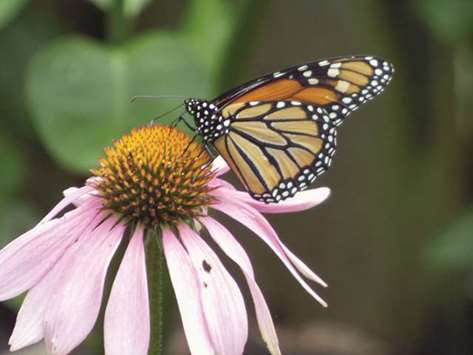This is a story that must begin at the end. But oh, what an end.
I stood on a forested mountaintop in Mexico in late February, mesmerised by monarch butterflies swirling around me, darting in and out of the trees and pockets of sunlight. They were high in the blue skies, clumped by the thousands on tree trunks and branches, clustered on woodland flowers and swarming in small streams of water on the forest floor. The sound of their wings was like a whisper on the breeze.
Beams of sunlight shone through 100-foot-tall oyamel fir trees like spotlights on a stage, with enough dancing butterflies to make a Bollywood extravaganza.
Bucket list experience? Absolutely.
Mingling with monarchs on a Michoacan mountaintop was a singular experience, mystical and almost spiritual.
My interest in monarchs started when I was a child, enjoying what has since, sadly, become unusual: an abundance of the orange, white and black butterflies floating through my Chicago backyard. As an adult, I noticed there were fewer monarchs around. I started learning about the decline of the monarchs, which once numbered in the billions, and about their near-miraculous – at least to me – annual migration to Mexico.
Each year in late summer and early fall, monarchs born in the northern US and Canada begin an epic journey of about 2,500 miles to mountaintops in Mexico – a place they’ve never been. It’s not clear how they know where to go. But somehow the fragile insects, each weighing about as much as a cotton ball, travel to the spot where their ancestors mated and began their own journey, at that time headed north.
The butterflies begin arriving in Mexico at the end of October and early November, close to the Day of the Dead. Some locals believe the butterflies are the souls of deceased ancestors. The monarchs stay in the forest until March, when they begin heading back north. Monarch populations are measured by the geographic size of the overwintering sites in Mexico. From a peak of about 45 acres in 1996-97, the size has been on a downward trend. In the 2016-17 winter, the area was estimated to be about 7 acres.
“What’s fair to say right now is that scientists estimate the population is at a pretty serious risk of getting so low that it might not be able to recover,” said Karen Oberhauser, director of the University of Wisconsin, Madison Arboretum and co-chair of Monarch Joint Venture, an organisation that co-ordinates monarch conservation efforts in the US.
The decline of the monarch population is largely because of habitat loss, both in the overwintering grounds in Mexico and in the northern breeding grounds. Monarchs only lay their eggs on milkweed plants, and that’s all their caterpillars eat. But milkweed has been disappearing from farm fields and elsewhere, mainly because of the use of herbicides.
Monarch numbers have been on the decline, but visitors to the high forests of central Mexico can still get an eyeful of the insects from November to March.
Mexico’s butterfly reserves were named a Unesco World Heritage Site in 2008. But Omar Vidal, CEO of the World Wildlife Fund in Mexico, notes that illegal logging in the butterfly reserves remains a concern.
“But even if Mexico’s overwintering sites never lose another tree,” he said, “without food and habitat along the migration routes, the forests will soon bid farewell to their final orange-and-black-winged tenant.”
El Rosario butterfly reserve, a little more than 100 miles west of Mexico City, is the largest sanctuary in the state of Michoacan, and it’s where I got my first look at the beautiful insects. It’s perched roughly 10,000 feet above sea level, and the altitude hit me hard. I was short of breath even at the entrance to the reserve. Rather than make an hour-long walk to the top, I rode a horse – a bargain at 100 pesos (about $5).
It took around 20 minutes over rough terrain for our group of about 10 people to make it to the top. Each horse is led by its own guide, so all the passengers have to do is hang on. After a few minutes riding under a dark forest canopy, we came upon a small dip in the trail that was flooded with sunlight and dozens of fluttering monarchs. The riders let out a few whoops, but the trail guides didn’t stop for photos.
At the top, a wide, sunlit meadow offered lots of photo ops. But our jaws didn’t drop until we went further into the dark forest and saw the butterflies clustered on tree trunks and branches, covering them in orange and
black.
“I was overwhelmed when I first entered the quiet and dark of the forest,” said Paula Zito, an operating room nurse from Sarasota, Fla. “I can’t believe they were circling me, surrounding my body, occasionally landing on my shoulder or backpack.”
Oberhauser, who has been studying monarchs since the 1980s, recalls her first visit to El Rosario in the ‘90s.
“I just looked into the trees and saw all the monarchs, and it was mystical ... and I just burst into tears,” she said. “It’s just an amazing thing to look at those butterflies and think that every single one of them has an amazing story of survival.”
I didn’t just see the butterflies – I felt them. A wing brushed my cheek, a pair landed on my shoulder, a few more on my hat. And I felt the joy of touching nature and whatever is spiritual in this world. –Chicago Tribune/TNS

THE TRAVELLER: This monarch butterfly was in a Chicago backyard this past July, meaning it most likely descended from one or more butterflies who wintered in Mexico earlier in the year.
